The Kindness of Strangers
By Robert Levine
People's willingness to help someone during a chance encounter on a city street varies considerably around the world
People's willingness to help someone during a chance encounter on a city street varies considerably around the world

DOI: 10.1511/2003.44.226
I'll never forget a lesson that I learned as a boy growing up in New York City. One day, when I was perhaps six years old, I was walking with my father on a crowded midtown street. All of a sudden, the normal flow of pedestrian traffic backed up as people tried to avoid a large object on the sidewalk.
To my astonishment, the object turned out to be a human being, a man lying unconscious against a building. Not one of the passing herd seemed to notice that the obstacle was a man. Certainly no one made eye contact. As we shuffled by, my father—the model of a loving, caring gentleman—pointed to a bottle in a paper bag and told me that the poor soul on the sidewalk "just needed to sleep it off." When the drunken man began to ramble senselessly, my father warned me not to go near, saying "You never know how he'll react." I soon came to see that day's lesson as a primer for urban adaptation.
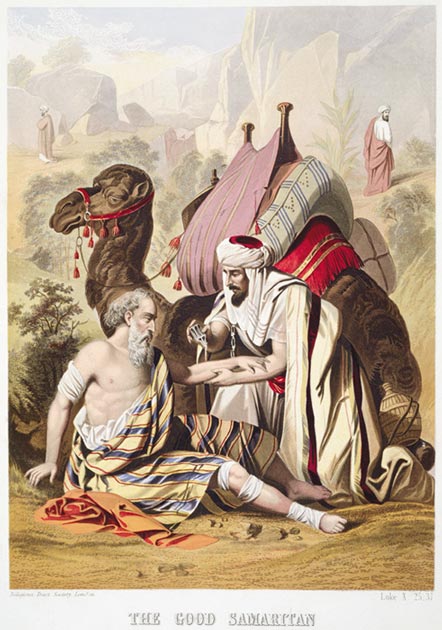
Historical Picture Archive / Corbis
Yet many years later I had a very different experience while visiting a market in Rangoon. I had spent the previous 12 months traveling in poor Asian cities, but even by those standards this was a scene of misery. In addition to being dreadfully poor, the residents had to contend with the sweltering climate, ridiculously dense crowds and a stiff wind blowing dust everywhere. Suddenly a man carrying a huge bag of peanuts called out in pain and fell to the ground. I then witnessed an astonishing piece of choreography. Appearing to have rehearsed their motions many times, a half dozen sellers ran from their stalls to help, leaving unattended what may have been the totality of their possessions. One put a blanket under the man's head; another opened his shirt; a third questioned him carefully about the pain; a fourth fetched water; a fifth kept onlookers from crowding around too closely; a sixth ran for help. Within minutes, a doctor arrived, and two other locals joined in to assist. The performance could have passed for a final exam at paramedic school.
Rousseau wrote that "cities are the sink of the human race." But as my experiences in New York and Rangoon make clear, not all cities are the same. Places, like individuals, have their own personalities. Which environments most foster altruism? In which cities is a person in need likely to receive help? I have spent most of the past 15 years systematically exploring these questions.
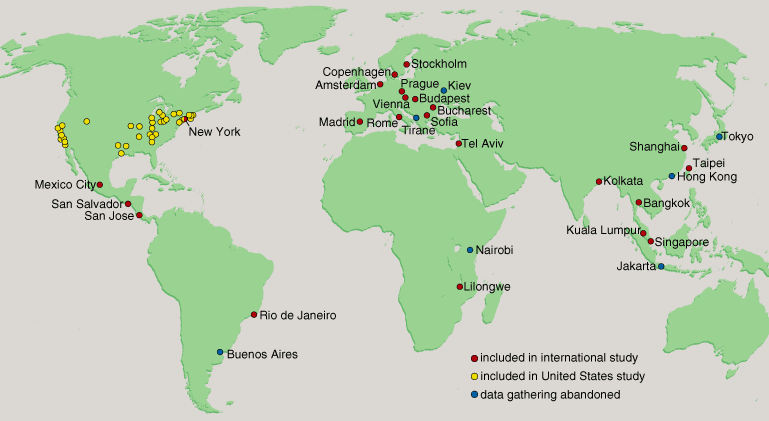
Emma Skurnick
My students and I have traveled across the United States and much of the world to observe where passersby are most likely to aid a stranger. In each of the cities we surveyed, we conducted five different field experiments. Our studies focused on simple acts of assistance, as opposed to Oskar Schindler—like heroism: Is an inadvertently dropped pen retrieved by a passing pedestrian? Does a man with an injured leg receive assistance picking up a fallen magazine? Will a blind person be helped across a busy intersection? Will someone try to make change for a quarter (or its foreign equivalent) when asked? Do people take the time to mail a stamped and addressed letter that has apparently been lost?
Our first studies were done in the early 1990s, when my students and I visited 36 cities of various sizes in different regions of the United States. The results did nothing to dispel my childhood impressions of New York. In an assessment that combined the results of these five experiments, New York came out dead last—36th out of 36. When we included a sixth measure of kindness toward strangers (per capita contribution to United Way), New York only moved up to 35th on the list. Overall, we found that people in small and medium-sized cities in the Southeast were the most helpful and that residents of large Northeastern and West Coast cities were the least.
One of the advantages of testing so many places is that we could see how other social, economic and environmental indicators correlated with our experimental results. Far and away the best predictor, we found, was population density. This parameter was more closely tied to the helpfulness of a city than were the crime rate, the pace of life, the prevailing economic conditions or environmental stressors—say, noise or air pollution. We could readily make a case that, overall, people in more crowded cities were much less likely to take the time to help. New York was Exhibit A.
This finding is, of course, easy enough to understand. Crowding brings out the worst in us. Urban critics have demonstrated that squeezing too many people into too small a space leads, paradoxically enough, to alienation, anonymity and social isolation. Ultimately, people feel less responsible for their behavior toward others—especially strangers. Previous research had shown that city dwellers are more likely to do one another harm. Our study indicated that they are also less likely to do one another good and that this apathy increases with the degree of crowding.
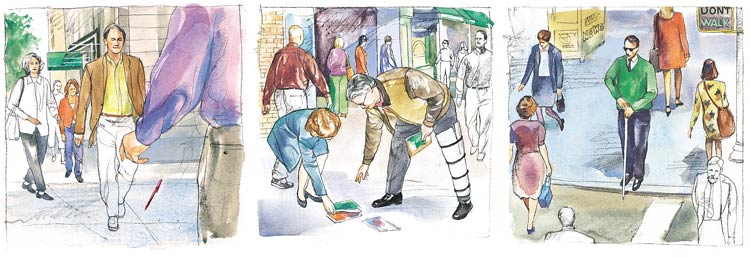
Dennis Balogh
But do all big cities exhibit this pattern? It was no surprise to find that densely packed cities like New York do not measure up to the communitarian standards of their smaller and calmer counterparts in the Southeast and Midwest. But as my experience in Rangoon showed, one comes across pockets of village cohesiveness in the most urban places. How do big-city dwellers from various countries compare? In particular, how does New York measure up to other large cities worldwide?
To answer these questions, for six summers Ara Norenzayan and more than 20 other adventurous students from my university worked with me to carry out five separate experiments in large cities around the world. In all, we ran nearly 300 trials of helpfulness that involved feigning blindness, dropped more than 400 pens, approached some 500 people while pretending to have a hurt leg or to be in need of change, and strategically lost almost 800 letters. To relate our findings to the situation in the United States, we used results for the same five experiments carried out in New York during our earlier study.
Psychologists who mount elaborate field studies are keenly aware that observing what doesn't work in experiments is sometimes as instructive as observing what does. True to this rule, our first noteworthy finding was that ways of measuring helping do not always translate cleanly across cultures. Two experiments in particular—those that involved asking for change and losing letters—simply do not have the same functional meaning in many countries that they have in the United States.

Emma Skurnick
The lost-letter test was the most troublesome. This experiment entails leaving stamped, addressed envelopes in a visible location on the street and then recording the percentage of these letters that get delivered. One problem we encountered was that people literally ran away from the letters in some cities. In Tel Aviv, in particular, where unclaimed packages have all too often turned out to contain bombs, people actively avoided our suspicious-looking envelopes. In El Salvador, our experimenter was informed about a popular scam in which shysters were intentionally dropping letters: When a good Samaritan picked one up, a con man appeared, announcing that he had lost the letter and that it contained cash (it didn't), then demanding the money back with enough insistence to intimidate the mild-mannered. Not surprisingly, very few letters were touched in El Salvador.
In many developing countries, we found that local mailboxes are either unattended or nonexistent. As a result, mailing a letter in these places requires walking to a central post office, rather than simply going to the letter box on the nearest corner. In Tirane, Albania (where we eventually gave up our attempts to gather data), we were warned not to bother with this experiment, because even if a letter were posted, it probably wouldn't arrive at its destination. (Of course, postal unreliability is also a factor in some more affluent nations.) And most problematic of all, in several countries we found that letters and postal communication are irrelevant to many residents' lives. In retrospect, we should have known better and been less ethnocentric when we designed the experiment. After all, what can one expect in India, for example, where the illiteracy rate is 52 percent?
The asking-for-change experiment also encountered a variety of problems in translation. In this study, the experimenter would ask someone walking in the opposite direction for change for a quarter (in the United States) or the equivalent in other currencies. Between monetary inflation and the widespread use of prepaid telephone cards, however, we learned that the need for particular coins has disappeared in many parts of the world. In Tel Aviv, for example, no one seemed to understand why a person might require small change. In Calcutta (a city that has now officially changed its name to Kolkata), our experimenter had difficulty finding anyone who had small-value bills and coins—reflecting a general shortage all over India at that time. In Buenos Aires, capital of the struggling Argentine economy, we wondered how to score the response of a person who replied that he was so broke that he couldn't even make change. In a few cities, people were afraid to exchange any money with strangers. In Kiev (another city for which we eventually gave up collecting data), where thieves run rampant, visitors are warned never to open a purse or wallet on the street.
In the end, we limited our cross-national comparisons to the tests in which the experimenter pretended to be blind, to have an injured leg or to accidentally drop a pen. Even these situations, we found, occasionally suffered in translation. In the hurt-leg trials, for example, we learned that a mere leg brace was sometimes insufficient to warrant sympathy. Take Jakarta, where experimenter Widyaka Nusapati reported that people don't usually bother to help someone with a minor leg injury. Perhaps if the limb were missing, Nusapati observed, the test might be valid there.
We found that in some cities, such as Tokyo and in parts of the United States, traffic light controls give off distinctive sounds so that the visually impaired will know when it is safe to walk, making it less likely that people would consider a blind person crossing an intersection as someone in need of aid. And, in a curious twist, the experimenter in Tokyo felt so compelled by the surrounding norms of civility that he found it nearly impossible to fake blindness or a hurt leg to attract well-meaning helpers. As a result, Tokyo could not be included in our final ranking.
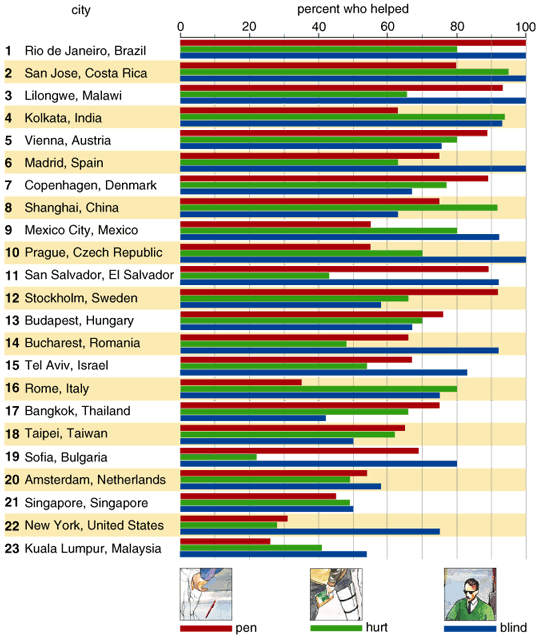
Emma Skurnick
Despite these difficulties, we ran the three tests successfully in 23 different countries—the largest cross-national comparison of helping ever conducted. What we found suggests a world of difference in the willingness of urbanites to reach out to strangers. In the blind-person experiment, for example, subjects in five cities—Rio de Janeiro, San Jose (Costa Rica, not California), Lilongwe, Madrid and Prague—helped the pedestrian across the street on every occasion, whereas in Kuala Lumpur and Bangkok help was offered less than half the time. If you have a hurt leg in downtown San Jose, Kolkata or Shanghai, our results show that you are more than three times more likely to receive help picking up a fallen magazine than if you are struggling on the streets of New York or Sofia. And if you drop your pen behind you in New York, you have less than one-third the chance that you do in Rio of ever seeing it again.
The two highest-ranking cities are in Latin America: Rio and San Jose. Overall, we found that people in Portuguese- and Spanish-speaking cities tended to be among the most helpful: The other three such cities on our list, Madrid, San Salvador and Mexico City, each scored well above average. Considering that some of these places suffer from long-term political instability, high crime rates and a potpourri of other social, economic and environmental ills, these positive results are noteworthy.
Social psychologist Aroldo Rodrigues, who is currently a colleague of mine at California State University, Fresno, spent most of his career as a leading scholar at universities in the most helpful city of all, Rio. Rodrigues was not surprised by our results. "There is an important word in Brazil: 'simpático,'" Rodrigues explains. "The term has no equivalent in English. It refers to a range of desirable social qualities—to be friendly, nice, agreeable and good-natured, a person who is fun to be with and pleasant to deal with. Mind you, simpático doesn't mean that a person is necessarily honest or moral. It is a social quality. Brazilians, especially the Cariocas of Rio, want very much to be seen as simpático. And going out of one's way to assist strangers is part of this image." This Brazilian social script also extends to the Hispanic cultures in our study, where a simpático personality is held in equally high regard.

David Schneider
There were other notable trends, although each had its exceptions. Helping rates tended to be high in countries with low economic productivity (low gross domestic product per capita—that is, less purchasing power for each citizen), in cities with a slow pace of life (as measured by pedestrian walking speeds) and in cultures that emphasize the value of social harmony. This city "personality" is consistent with the simpático hypothesis. People in communities where social obligations take priority over individual achievement tend to be less economically productive, but they show more willingness to assist others. This trend did not, however, hold for all of the cities in our study. Pedestrians in the fast-paced, first-world cities of Copenhagen and Vienna, for example, were very kind to strangers, whereas their counterparts in slower-paced Kuala Lumpur were not helpful at all. These exceptions make clear that even city dwellers with a fast pace of life and a focus on economic achievement are capable of finding time for strangers in need and that a slow pace of life is no guarantee that people will invest their leisure time in practicing social ideals.
New York may not have ranked lowest in our global study, as it had in our earlier tests of helpful acts in various U.S. cities, but it came close. Overall, New Yorkers placed 22nd in our list of 23. They ranked 22nd on tests of whether people would retrieve a dropped pen and of whether they would assist someone with a hurt leg. They came out a little below the average (13th) when it came to helping a blind person to cross the street.
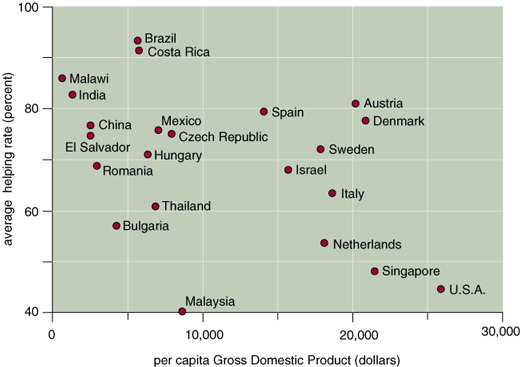
David Schneider
We also learned that there may be a difference between helping and civility. In places where people walked fast, they were less likely to be civil even when they did offer assistance. In New York, helping gestures often had a particularly hard edge. During the dropped-pen experiment, for example, helpful New Yorkers would typically call to the experimenter that he had dropped his pen, then quickly move on in the opposite direction. In contrast, helpers in laid-back Rio—where a leisurely gait and simpático personality are ways of life—were more likely to return the pen personally, sometimes running to catch up with the experimenter. In the blind-person trials, helpful New Yorkers would often wait until the light turned green, tersely announce that it was safe to cross and then quickly walk ahead. In the friendlier cities, helpers were more likely to offer to walk the experimenter across the street, and they sometimes asked if he then needed further assistance. Indeed, one of our experimenters' problems in these place was how to separate from particularly caring strangers.
In general, it seemed as though New Yorkers are willing to offer help only when they could do so with the assurance of no further contact, as if to say "I'll meet my social obligation but, make no mistake, this is as far as we go together." How much of this attitude is motivated by fear and how much by simply not wanting to waste time is hard to know. But in more helpful cities, like Rio, it often seemed to us that human contact is the very motive for helping. People were more likely to give aid with a smile and to welcome the "thank you" our experimenter returned.
Perhaps the most dramatic example of uncivil helping involved one of the tests we attempted and then abandoned, the lost-letter experiment. In many cities, I received envelopes that had clearly been opened. In almost all of these cases, the finder had then resealed it or mailed it in a new envelope. Sometimes they attached notes, usually apologizing for opening our letter. Only from New York did I receive an envelope which had its entire side ripped and left open. On the back of the letter the helper had scribbled, in Spanish: "Hijo de puta ir[r]esposable"—which I discovered when it was translated for me, makes a very nasty accusation about my mother. Below that was added a straightforward English-language expletive, which I could readily understand. It is interesting to picture this angry New Yorker, perhaps cursing my irresponsibility all the while he was walking to the mailbox, yet for some reason feeling compelled to take the time to perform his social duty for a stranger he already hated. Ironically, this rudely returned letter counted in the helping column in scoring New York. A most antipático test subject, as the Brazilians would say.
Compare this response to those in Tokyo, where several finders hand-delivered the letters to their addressees. Or, consider a note I received on the back of a returned letter from the most helpful city in our earlier study of U.S. cities, Rochester, New York:
Hi. I found this on my windshield where someone put it with a note saying they found it next to my car. I thought it was a parking ticket. I'm putting this in the mailbox 11/19. Tell whoever sent this to you it was found on the bridge near/across from the library and South Ave. Garage about 5 p.m. on 11/18.
P. S. Are you related to any Levines in New Jersey or Long Island? L. L.
Do our results mean that New Yorkers are less kind people—less caring on the inside—than city dwellers in more helpful places? Not at all. The New Yorkers to whom we spoke gave many good reasons for their reluctance to help strangers. Most, like me, had been taught early on that reaching out to people you don't know can be dangerous. To survive in New York, we were told, you should avoid even the vaguely suspicious.
Some also expressed concern that others might not want unsolicited help, that the stranger, too, might be afraid of outside contact or might feel patronized or insulted. Many told stories of being outright abused for trying to help. One woman described an encounter with a frail, elderly man with a red-tipped cane who appeared unable to manage crossing an intersection. When she gently offered assistance, he barked back, "When I want help I'll ask for it. Mind your own f---ing business." Others told of being burned once too often by hustlers. One nonhelper commented that "most New Yorkers have seen blindness faked, lameness faked, been at least verbally accosted by mentally ill or aggressive homeless people. This does not necessarily make one immune or callous, but rather, wary."
Over and again, New Yorkers told us they cared deeply about the needs of strangers, but that the realities of city living prohibited their reaching out. People spoke with nostalgia for the past, when they would routinely pick up hitchhikers or arrange a meal for a hungry stranger. Many expressed frustration—even anger—that life today deprived them of the satisfaction of feeling like good Samaritans.
These explanations may simply be the rationalizations of uncharitable citizens trying to preserve their self-image. But I do not think this is the case. The bulk of the evidence indicates that helping tends to be less dependent on the nature of the local people than it is on the characteristics of the local environment. And investigators have demonstrated that seemingly minor changes in situation can drastically affect helping—above and beyond the personalities or moral beliefs of the people involved. It is noteworthy that studies show the location where one was raised has less to do with helping than the place one currently lives. In other words, Brazilians and New Yorkers are both more likely to offer help in Ipanema than they are in Manhattan.
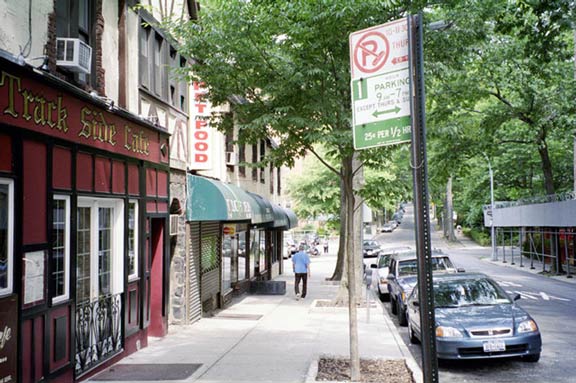
Courtesy of Joseph De May, Jr.
Yet the cause of civility in cities like New York and Kuala Lumpur may not be hopeless. Just as characteristics of the situation may operate against helping, there are ways to modify the environment so as to encourage it. Experiments have shown, for example, that reversing the anonymity and diffusion of responsibility that characterize life in some cities—by increasing personal accountability, or simply by getting people to address one another by name—boosts helping. In a 1975 experiment at a New York beach, Thomas Moriarity, then a social psychologist at New York University, found that only 20 percent of people intervened when a man (actually one of the experimenters) blatantly stole a portable radio off of the temporarily abandoned blanket next to them. But when the owner of the radio simply asked her neighbors to keep an eye on the radio while she was gone, 95 percent of those who agreed stepped in to stop the snatcher.
Inducing a bit of guilt—by making people aware that they could be doing more—also seems to make a difference. Perhaps most promising is the observation that helping can be effectively taught. Psychologists have found, for example, that children who are exposed to altruistic characters on television tend to mimic them. And, because prosocial exemplars in real life often induce others to follow suit, any increases in helping are potentially self-perpetuating.
Might a kinder environment eventually raise the level of helpfulness in New York? This city is leading a nationwide trend and currently enjoying a wave of crime reduction. (Statistics indicate that fewer New Yorkers are doing each other injury today than in the recent past.) Could diminished worries over street crime free more people to step forth and offer one another aid, strangers included? Our experiments do not address variations over time, but I suspect that little will change. After all, the reduction in the number of harm-doers does not necessarily imply that there will be greater quantity of altruism practiced. And there is little doubt that the drunk man I watched people sidestep when I was six would be even less likely to receive help from a passing stranger today.
A little more than a century ago, author John Habberton may have had New Yorkers in mind when he wrote that "nowhere in the world are there more charitable hearts with plenty of money behind them than in large cities, yet nowhere else is there more suffering." Perhaps good Samaritans are indeed living in New York in large numbers but are hiding behind protective screens. To strangers in need of help, it would make little difference, thoughts being less important than actions. The bottom line: One's prospects for being helped by a stranger are bleaker in New York than they are in Rio, Mexico City or Shanghai. Indeed, you're more likely to receive assistance from someone you don't know just about anywhere else in world.
© Robert V. Levine
Click "American Scientist" to access home page
American Scientist Comments and Discussion
To discuss our articles or comment on them, please share them and tag American Scientist on social media platforms. Here are links to our profiles on Twitter, Facebook, and LinkedIn.
If we re-share your post, we will moderate comments/discussion following our comments policy.